tags: Seattle Washington, Biology Department Greenhouse, University of Washington, poison dart frogs, Dendrobates, Dendrobatidae
Captive-bred Dyeing Poison Dart frog, Dendrobates tinctorius, from the Guianas of northeastern South America.
Image: GrrlScientist 29 September 2008 [larger view].
This is part two of my UW Biology Department greenhouse photoessay. In part one, I showed you seedpods and a lot of flowers (some of which need to be identified), but in this, the second and last part, I am focusing on The Surprise I kept telling you about. As you can see, the surprise discovery I made in the greenhouse is the poison dart rainforest frogs! I am especially proud of these pictures because these tiny frogs move extremely quickly, so they are very difficult to photograph.
Even though they move quickly, these cute little frogs are not the least bit shy, as you can see in this image;
Captive-bred Dyeing Poison Dart frog, Dendrobates tinctorius, from the Guianas of northeastern South America.
Image: GrrlScientist 29 September 2008 [larger view].
However, these bold little frogs will readily come out of hiding to actively hunt down live fruit flies. Watching them hunt is absolutely fascinating; they obviously have very keen eyesight, and are very curious about new people and unsual objects. For exmaple, one of them was particularly intrigued by my camera.
There frogs were gifts to the greenhouse. Two different people who worked at the University of Washington were hobbyist poison dart frog breeders, and they donated all these frogs to the UW greenhouse. Currently, the greenhouse keeps six individual Dyeing Poison Dart frogs, Dendrobates tinctorius, and one lonely Yellow-banded Poison Dart frog, Dendrobates leucomelas.
Left; captive-bred Yellow-banded Poison Dart frog, Dendrobates leucomelas, from Venezuela, Guyana and Brazil. Right; captive-bred Dyeing Poison Dart frog, Dendrobates tinctorius, from Guyana, Suriname, Brazil, and nearly all of French Guiana.
Image: GrrlScientist 29 September 2008 [larger view].
The Dyeing Poison Dart is especially variable from one population to another, and several color morphs have been described. Each population of this species is so distinctly marked that they can be readily distinguished by humans. As you can see, this frog is bright blue with two broad yellow stripes down the back, which are connected by yellow cross bands that produce either two or three oval blue splotches on the middle of the back. The arms and legs are black or deep blue with many bright yellow or black spots. In some color morphs, yellow is replaced with white or the two yellow stripes fuse across the back to produce a frog with a solid yellow back on a bright blue or black background. Individuals can be easily distinguished by their markings, which show tremendous variability between different populations as well as between individuals of the same species.
Captive-bred Dyeing Poison Dart frog, Dendrobates tinctorius, from the Guianas of northeastern South America.
Image: GrrlScientist 29 September 2008 [larger view].
For example, compare the markings on the backs of these two individual Dyeing Poison Dart frogs -- they are easy to distinguish, aren't they?
Captive-bred Dyeing Poison Dart frog, Dendrobates tinctorius, from the Guianas of northeastern South America.
Image: GrrlScientist 29 September 2008 [larger view].
The Dyeing Poison Dart frog is the largest poison dart frog species, attaining lengths of roughly 50 millimetres (2.0 inches), although some females, which are just as brightly colored as the males, may reach 60 millimeters. They, like all poison dart frogs, lack a waxy coating on their skin to seal in moisture so they live in the wet understory of the Central and South American rainforests, where its bright yellow stripes contrast sharply with the darkness of the vegetation.
Captive-bred Dyeing Poison Dart frog, Dendrobates tinctorius, from the Guianas of northeastern South America.
Image: GrrlScientist 29 September 2008 [larger view].
Their bright yellow coloring is used as a visual defense of their territory, although male frogs will also call, producing a variety of humming, trilling or chirping sounds to defend their territory and to attract a mate. After a gravid female makes an appearance, amplexus occurs on land, and the male deposits sperm over the eggs as the female lays them. She typically produces eight to ten eggs. When the tadpoles are ready to hatch, the male carries them on his back to water where he deposits each one individually -- siblings tend to be very aggressive towards each other, eating anything that fits into their mouths, including each other. The males visit each member of the brood as they mature.
Captive-bred Dyeing Poison Dart frog, Dendrobates tinctorius, from the Guianas of northeastern South America.
Image: GrrlScientist 29 September 2008 [larger view].
The Dyeing Poison Dart frog is one of the easiest poison dart frog species to propagate in captivity and thus, it is quite popular in the pet trade. They eat live fruit flies and pinhead crickets as adults while the tadpoles eat flaked fish food.
This particular species of Poison Dart frog got both its common name, "Dyeing", and its specific name, tinctorius, from a peculiar practice rumored to occur among some of the indigenous South American tribes. They did not use this species to poison their hunting darts, but supposedly, they did rub these frogs on the skin of young parrots before their feathers began to grow, which causes the birds to grow bright red feathers instead of the usual green. This practice was known as "tapirage".

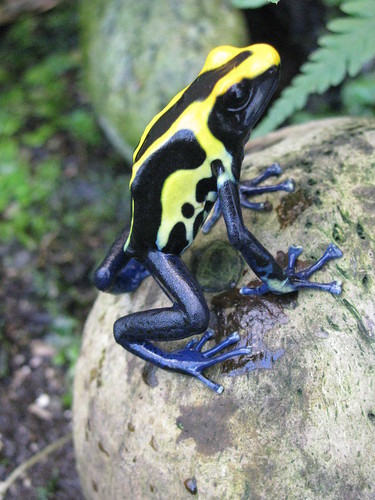
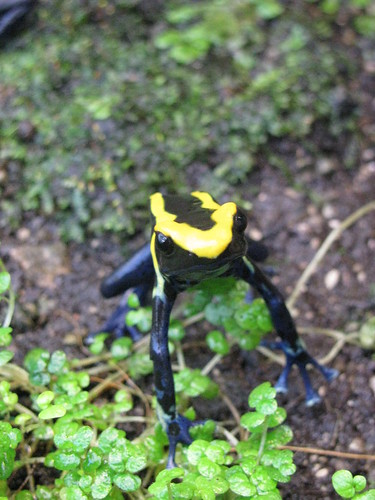

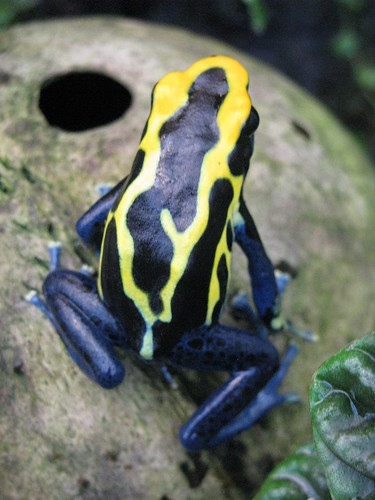
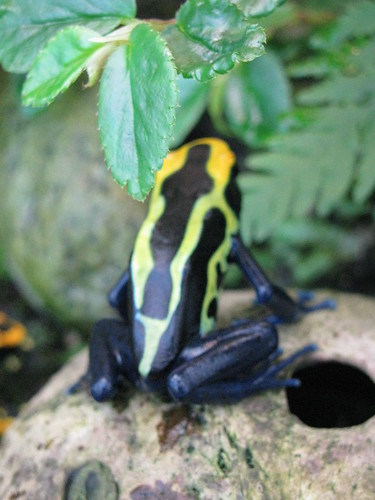

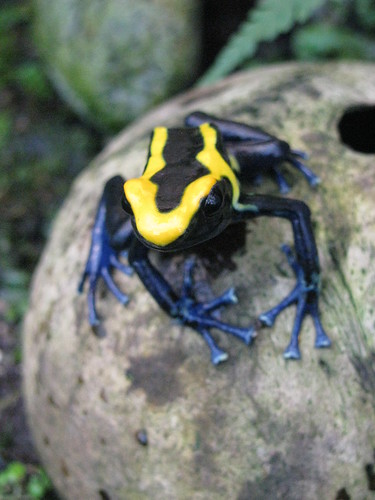
Very cool.
Thanks for sharing the photos!
"tapirage"- great fact
Great photos! It is interesting to see the pattern variability.
Great photo! (Though of course I prefer birds.)
Have you considered moving back to Washington state? (Btw, UW to me means University of Wisconsin since I live in Madison.
Very, very nice photos (love the first two, especially). The bright colors, for some reason, make me want to not put them in my mouth.
HJ
Great photos. Frogs and toads have been my favorite neighbors down here in Houston. Gulf Coast Toads, Green Tree Frogs, loudly-screeching Cricket Frogs (imagine a Velociraptor dragging its big claw across a blackboard), Eastern Narrowmouth toads squealing after every big rain . . . And then there was the directive from Texas Parks & Wildlife to Amphibian Watch monitors who gather Anurans to check their little fingers and toes: don't put frogs and toads of different sizes into the same container or else the bigger ones will eat the little guys.
Great photos. Frogs and toads have been my favorite neighbors down here in Houston. Gulf Coast Toads, Green Tree Frogs, loudly-screeching Cricket Frogs (imagine a Velociraptor dragging its big claw across a blackboard), Eastern Narrowmouth toads squealing after every big rain . . . And then there was the directive from Texas Parks & Wildlife to Amphibian Watch monitors who gather Anurans to check their little fingers and toes: don't put frogs and toads of different sizes into the same container or else the bigger ones will eat the little guys.
Sorry about the double commnet. Sciblogs was having comment hiccups this morning.